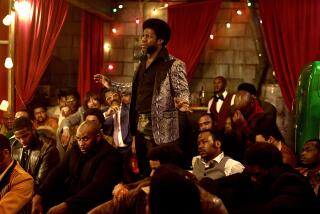Sketches of Chicago 7 trial will go on display
- Share via
chicago -- A defendant is shown in judicial robes, reading in court. Another drawing, shaded in murky brown, depicts a celebrity poet testifying in Sanskrit. A third captures an indignant defendant describing how he was bound and gagged in the courtroom for calling the judge a “fascist” and a “dog.”
These images are among 483 courtroom sketches from the 1969-70 Chicago Seven conspiracy trial that were acquired recently by the Chicago History Museum. The pictures, the work of famous news artist Franklin McMahon, tell the story of a bizarre spectacle in American courtroom history, a trial that reflected the alienation of the 1960s youth counterculture from the previous generation.
“The historical significance is that it’s one of the first places in a formal setting that you see just how different young people’s views were from the generation that they saw themselves up against,” said Joy Bivins, a curator at the museum. “That these really critical issues of the Vietnam War, youth counterculture and civil rights all come together in one place is unique.”
The drawings, once sorted, will be exhibited at the museum. Drawn in shades of black, brown and deep auburn, they provide snapshots of a supremely colorful trial in which the defendants wore jeans, ate, editorialized aloud and slept during the court proceedings.
“The judge was uptight, and these guys were running revolution by show business,” McMahon says. “They were out there to make a scene, and they did.”
The trial began on Sept. 24, 1969, 13 months after violence broke out during the 1968 Democratic National Convention in Chicago. Protesters in Grant Park were clubbed and gassed; one observer described the police as hitting the crowd like “sheets of rain.”
The government charged eight men with conspiring to incite a riot. The number originally included Bobby Seale, leader of the Black Panthers, who was bound and gagged in court because of insults he hurled at Judge Julius Hoffman. Seale eventually was severed from the case and sentenced to four years in prison for contempt of court.
That left seven defendants: Abbie Hoffman, Jerry Rubin, David Dellinger, Rennie Davis, Tom Hayden, John Froines and Lee Weiner. Their trial became a microcosm of the tensions playing out across the nation.
McMahon, 86, who has drawn everything from the protests in Selma, Ala., to the Paris Opera, says the trial was among his most important subjects.
“I thought the acts of the defendants were atrocious, but I was on their side in the sense I was against the war and in the sense I was more of a Democrat than a Republican,” he said.
As the artist scanned his Chicago Seven drawings, he recalled some of the more humorous private moments from the case -- ones not captured on the record or on paper.
Bobby Seale, he said, would enter the courtroom and address the jurors: “Good morning! I hope you don’t blame me for anything.”
And in the pressroom, when McMahon showed Abbie Hoffman a drawing of the jury, Hoffman responded by commenting on each person: “Oh, this one here’s on our side. That guy will never vote for us; he wears white socks.”
McMahon’s drawings from the trial were published across the nation in 1969 and 1970. The pictures vary in size from a small, vibrant portrait of Judge Hoffman to a panoramic image of poet Allen Ginsberg chanting Sanskrit prayers and uttering drawn-out “Oms” during his testimony.
Other celebrities sketched include Arlo Guthrie, who recited lyrics from “Alice’s Restaurant” on the stand, writer Norman Mailer and folk musician Pete Seeger.
One drawing provides a panoramic view of the courtroom and measures 5 feet across. The defendants sit in the foreground, huddled around their table, wearing bemused expressions.
“This courtroom kind of became a theater for acting out all of those important issues of the day,” Bivins said. “One of the reasons these illustrations are really important is because you can read page after page, but you are rarely going get a chance to visualize all the actors involved in this kind of courtroom drama.”
Five months after the trial began in the oak-paneled, 23rd-floor courtroom of the Dirksen Federal Courthouse, the defendants were acquitted of conspiracy. Five were convicted of intending to incite a riot across state lines and sentenced to five years in prison. In addition, all seven, plus the two defense attorneys, were given lengthy sentences for more than 100 contempt of court citations.
But in November 1972 an appeals court reversed all of the convictions, citing, among other things, antagonistic behavior from the judge and the fact that the FBI had bugged the defense lawyers’ offices.
The Chicago History Museum purchased the illustrations for an undisclosed sum in August from McMahon, whose work has appeared in the Chicago Tribune, the Washington Post, the New York Times, Fortune, Life and Sports Illustrated, among other publications.
“What we are really trying to do is place this work where the public can see it,” explained McMahon’s son, Mark, who first contacted the museum about the drawings.
The museum already possesses the trial papers and notes from Judge Hoffman, so the pictures made a nice addition. Now, staffers just have to decide which drawings to exhibit.
“There are just so many of them,” Bivins said. “The challenge is going to come when we try to decide which ones are the most significant ones and which ones to show the public.”
More to Read
Sign up for Essential California
The most important California stories and recommendations in your inbox every morning.
You may occasionally receive promotional content from the Los Angeles Times.










